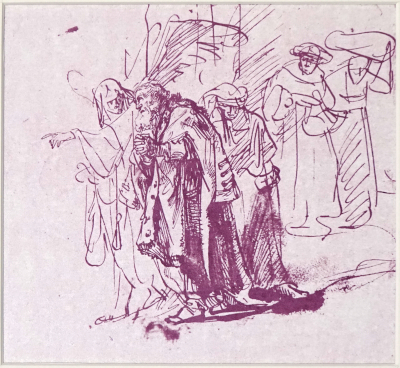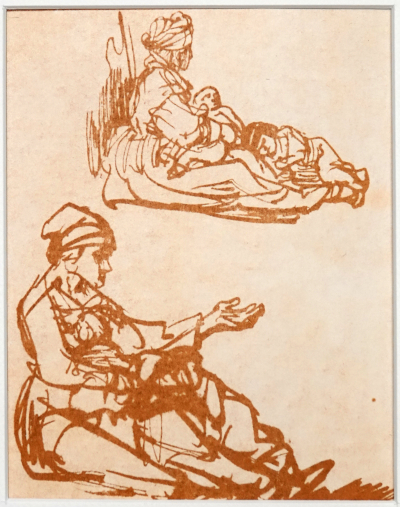Bichromate gum technique
The bichromate gum technique was invented to
reproduce works without having to engrave them. Engraving was
the only reproduction technique that existed until the middle
of the 19th century (see for example of the very beautiful burin
engraving by J. B.
Danguin (1823-1894) of
the portrait of Hendrickje
Stoffels from 1654 and the wooden
press of Plantin’s
house in Antwerp). The
discovery
of photosensitive reproduction processes (the technique of
gum dichromate is part of the whole process) around 1850 and
in the field of printing the invention of the Linotype
(Ottmar Mergenthaler) and the Monotype (Tolbert Lanston)
around 1880 revolutionized reproduction techniques. Their
purpose was to reproduce works more easily than the use of
engraving and especially to make a very large number of
prints.
In 1832, Gustav Suckov discovered chromates were sensitive
to light. In 1839, Mungo Ponton noticed that a paper
soaked in a solution of potassium bichromate was sensitive
to light. In 1840, Edmond Becquerel noted that sensitivity
to light could be increased if the paper was coated with
starch or gelatin. In 1852, William Henry Fox Talbot
showed that colloids, such as gelatin or gum arabic,
became insoluble after being mixed with potassium
bichromate and after exposure to light. In 1855, Alphonse
Louis Poitevin patented the charcoal process, which
consists of adding charcoal to the colloid + potassium
bichromate mixture. In 1858, John Pouncy used colored
pigments with the gum arabic + potassium bichromate
mixture, defining the bichromate gum technique and thus
obtained the first colour prints. The great photographer
who used the bichromate gum technique at the beginning of
the 20th century was Robert
Demachy.
Watercolor or gouache are mainly made up of a
binder, gum arabic, made of acacia sap, and pigments which
define colour. Gum arabic is a water-soluble glue. It is
said to be reversible, because after drying it can be
dissolved again into water. Paints using gum arabic as a
binder are reversible, and when painted and dry, they can
be washed because gum arabic dissolves in water. If
potassium bichromate is added to the water + gum arabic +
pigment mixture, a photosensitive paint is obtained which,
after exposure to UV, becomes insoluble. To make a
bichromate gum print, a layer of the photosensitive
mixture is painted on watercolour paper. When the
photosensitive layer is dry, it is covered with a negative
and exposed to UV radiation. After exposure, one puts the
paper in water. The parts of the photosensitive layer
which have been exposed to UV adhere to the paper, the
others will dissolve in water. We can therefore reproduce
a photo, a drawing, an etching or a flower ... using the
technique of bichromate gum. You can superimpose several
prints of different colours. It is a technique that lies
between engraving, printing, painting and photography. It
is a simple process which gives very good results.
This technique is particularly well suited to
reproduce Rembrandt's drawings and etchings. It does not
provide a simple copy, it makes it possible to obtain
stable prints which are more beautiful than photographs.
It therefore offers the possibility of exploring and
presenting the fascinating world of Rembrandt's drawings
and studying their links with his etchings. However, it is
an artisanal process which takes a long time to implement
and does not allow large numbers of prints.
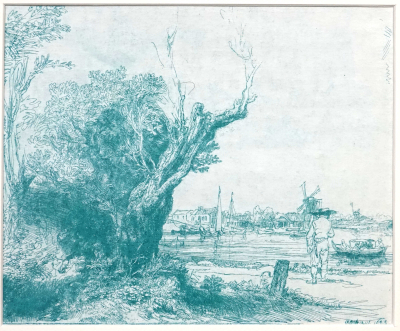
Omval (1641), {Rijksmuseum, Amsterdam}, depicts a village located on the outskirts of
Amsterdam, along the Amstel River. This etching is an
iconic work by Rembrandt, in which he captures life on the
river: a pedestrian interacts with the occupants of a
passing boat, while, almost imperceptibly, lovers hide in
the foliage behind a tree. The lovers symbolize freedom
from religious conventions, serving as a subtle defiance
by Rembrandt against the religious authorities who had
condemned his lifestyle as immoral. This etching breathes
life, far from giving the impression of a static image.
For Rembrandt, the village of Omval, though the subject of
the etching, becomes secondary to the vibrancy of the
riverbank and the flowing water. Notably, in the upper
right corner of the etching, small strokes made by
Rembrandt can be seen, used to test the point that allowed
him to work through the varnish layer. True to his free
spirit and indifferent to public opinion, Rembrandt is one
of the very few etchers to leave his trials or even his
mistakes visible on the plate.
The de Run
mill in Omval (circa 1688-90), {Rijksmuseum, Amsterdam}, is an etching made by Jan Vincentsz van der Vinne,
after Laurens Vincentsz van der Vinne. This etching,
produced about fifty years after Rembrandt’s, also depicts
life on the river at Omval. From a technical perspective, it
is a very beautiful etching. However, it clearly illustrates
the difference in subject treatment between Rembrandt and
his contemporaries, highlighting the unique freedom and
expressiveness that Rembrandt brought to his drawings and
etchings.
Rembrandt had a very strong personality, he never let
himself be influenced by what people might say,
conventions or fashion changes, his only concern was to
represent life as it was and he let himself be guided by
extraordinary inspiration and vision. This way of doing
confused many of his contemporaries and great collectors.
For example The
Night Watch painting was admired but
found disconcerting. His painting The
Conspiracy of the Batavians under Claudius Civilis (1661), made at the request
of the Amsterdam city hall, was rejected by the latter.
Finally, some of his etchings, considered immoral or
vulgar, were never acquired by certain great collectors.
His way of life was considered immoral by religious
authorities and many of his contemporaries, and note that
even at the peak of his glory, he was never invited to
Muiden Castle, where the influential circles of
Amsterdam's artistic life met.
His sentimental life was not a
long, calm river. In 1634, he married Saskia van
Uylenburg, his great love. His first three children did
not survive, only the fourth, Titus, lived to become an
adult. Saskia died in 1642. He then started a liaison
with Geertje Dircx, but then again, his new love with
Hendrickje Stoffels caused a particularly dramatic break
with Geertje. With Hendrickje, he had a daughter,
Cornelia. Hendrickje died probably of the plague in 1663
and Titus died of the plague in 1668, a year before
Rembrandt.
His works
often contain hidden messages. For example, the painting The
Return of the Prodigal Sun (1668 -
1669). Rembrandt wanted to represent the prodigal son
received by his father and his mother whereas on the
painting only the father receives the son, he therefore
suggested the presence of the mother by painting a woman's
hand and a man's hand for the father. It is painted in
such a remarkable way that it is not shocking and is not
noticeable at first sight. In the painting Landscape
with the Stone Bridge (circa 1638), the light
which crosses a very dark and tormented sky, illuminates
the canal, the bridge and the farm, places of life,
while the church receives no light.
Rembrandt, in addition being a
painter, was also an art dealer and a great
collector of works, various objects and clothes
which he used for his paintings. He was in constant
conflict with art dealers because he wanted the
works to be paid their fair price. They took revenge
when they could, and came to an agreement during the
sale following his bankruptcy so that the prices
remained ridiculously low, leading to a colossal
failure. At the height of his glory, Rembrandt made
a lot of money, but spent it easily, several factors
including a hazardous investment made that he could
no longer repay the mortgage for his house. After
his bankruptcy and the sale of all his property
(1656 - 1658), Rembrandt continued to paint and
produced some of his most beautiful paintings. He
received some orders, but died in misery. After his death there was not
enough money left to pay him a grave.
Self-portrait (circa 1628-29, Benesch, B 54, circa
1629, Schatborn &
Hinterding, D
628), {Rijksmuseum, Amsterdam},
is a drawing made with brush and pen during the Leiden
period. It is one of the earliest preserved
self-portraits by Rembrandt. The artist created
numerous self-portraits, not only in drawing but also
in etching and painting. These works allowed him, from
the very beginning, to perfect his etching technique
and study facial expressions to convey different
emotions, such as fear, astonishment... Later,
his self-portraits also became a way to track the
evolution of his face throughout his life. His last
painting is a self-portrait. The main characteristic of
his self-portraits lies in the emotion and humanism they
convey. In his works, he frequently portrayed himself.
When he became famous, many people wanted to acquire a
portrait of Rembrandt, which motivated him to produce even
more self-portraits.
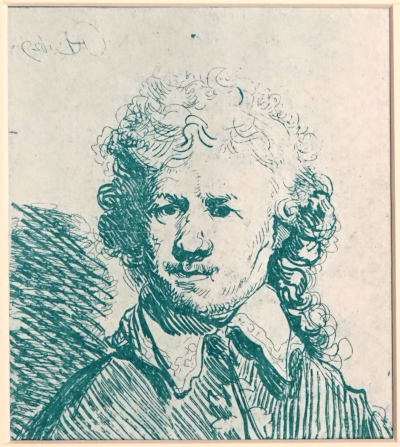 Self-portrait
(circa 1629), {Rijksmuseum, Amsterdam}, etching
made from the drawing Self-portrait
from 1628-29, is an etching made after the drawing Self-Portrait of
1628–1629. It is one of Rembrandt's earliest
etchings, as he began etching around 1625–1626. To
preserve the flexibility and spontaneity of the
line, Rembrandt drew directly onto the metal plate,
as he would on a sheet of paper, resulting in a
reversed print. The
engraving technique that maintains this flexibility
and spontaneity is etching. In this technique, the
copper plate is first coated with a varnish. Rembrandt
then draws on it with a fine point, removing the
varnish. The plate is then immersed in an acid bath
(known as aqua fortis in the 17th century), which bites into the
copper where the varnish has been removed. It is
interesting to compare this etching with Self-Portrait with Arm Resting on a Stone
Ledge, made ten years
later. When drawing or painting a self-portrait,
Rembrandt looked at himself in a mirror, causing the
image to be reversed. However, when etching a
self-portrait based on one of his drawings, he would
reproduce the drawing onto the metal plate, and the
final print would be reversed compared to the original
drawing. As a result, the final print becomes a
non-reversed representation of Rembrandt, as he would
have appeared in reality. Rembrandt’s most beautiful
self-portrait is probably the 1639 etching, which
could be considered a true “photograph” of the
artist at that moment in his life.
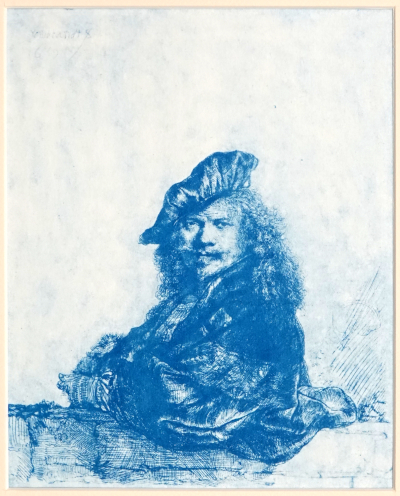
Self-Portrait with Arm
Resting on a Stone Ledge (1639),
{Rijksmuseum, Amsterdam},
is an etching to be compared with the Self-Portrait
of 1629. At this time, Rembrandt reached the peak
of his etching artistry, creating one of his most
beautiful self-portraits. However, on the right
side of the etching, he left a rough sketch and
additional pencil strokes (the stones of the
wall). These elements suggest that this print is
probably one of the first, and that Rembrandt
questioned whether he would continue working on
the plate. Ultimately, he deemed the etching
complete and left it as it was. What seems to interest him most is the
portrayal of his facial expression and the luxury of
his clothing. The sketched lines also indicate a
certain nonchalance towards artistic conventions and a
sense of detachment from the image he projects.
Rembrandt appears to mock the idea of formal
perfection, favoring a more spontaneous and personal
representation. The sale of prints from his etchings
provided a regular and significant source of income
for the artist. This etching would later be followed
by the painting Self-portrait
at the age of 34.
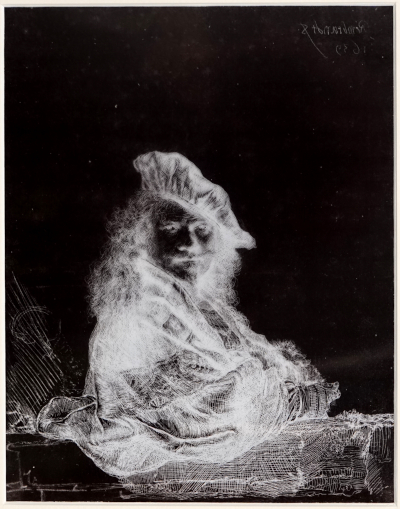
Above,
one can see the transparent used in the gum
bichromate technique to reproduce the etchving Self-Portrait
with
Arm Resting on a Stone Ledge
(1639). The transparent is placed on the sheet
painted with the photosensitive watercolor, and
the whole setup is then exposed to UV radiation.
This radiation passes through the transparent in
the white areas, which are clear. After
exposure, the sheet is immersed in water. The
parts of the photosensitive layer that were
exposed to UV adhere to the paper, while the
others dissolve in the water. In this way, the
reproduction of Rembrandt's etching is obtained.
The exposure time to UV radiation
depends on the color of the watercolor used. In the
gum bichromate technique, the transparent plays a
similar role to that of the metal plate in etching,
serving as a support for reproduction.
We will focus on Rembrandt's drawings as well as his
etchings, which are inseparable from his drawings.
These two mediums were Rembrandt's preferred means of
carrying out his experiments on how to depict life as
he observed it around him. Rembrandt was one of the
greatest draftsmen and etchers of all time. Alongside
Katsushika Hokusai (1760–1849) and Käthe Kollwitz
(1867–1945), he was one of the artists who best
expressed the feelings of the human beings and animals
he drew, as well as the atmosphere of the scenes or
landscapes he wished to represent.
The main characteristic of Rembrandt's drawings is
the freedom of line and the sometimes completely
unpredictable nature of the stroke. In his
documentary “Le mystère Picasso”
(1956), Henri-Georges Clouzot attempted to answer
the question: what goes on in a painter's mind when
he works? We can trace Rembrandt's creative process
by observing how his preparatory drawings, sometimes
very rudimentary, allowed him, when he felt
ready—sometimes after several years of reflection—to
produce a masterpiece. The final result, technically
unsurpassable, has the appearance of the greatest
magic tricks: seemingly effortless, yet technically
incomprehensible, and nevertheless perfect (see, for
example, the etching The
Hundred Guilder Print
and its preliminary studies). We can follow the various problems Rembrandt
solved at each stage of his work. In the first phase, he
analyzed issues of movement and construction. In the
second phase, once these problems were understood, he
focused on the expression of characters or animals, as
well as on capturing the atmosphere of the scene he was
depicting. Finally, in a third stage, he placed shadows
and lights to indicate volumes and the hierarchy of
planes. Rembrandt also enjoyed copying the old masters
to enrich his practice.
He probably made sketches
every day. Over forty years, based on three sketches
per day, it can be estimated that he produced a
minimum of forty thousand sketches or drawings. Only
certain drawings—such as landscapes, biblical
scenes, or scenes of everyday life—can be considered
highly finished works. But most of the time, they
were intermediate sketches, which unfortunately did
not attract the interest of his contemporaries or
collectors. As a result, the vast majority of his
preliminary drawings have disappeared.
Rembrandt had many students who drew in his style.
Since most of the drawings were neither dated nor
signed, it can be extremely difficult to date and
attribute the drawings to Rembrandt with certainty.
After his bankruptcy and
the sale of his house, press, collections, and
possessions in 1658, Rembrandt had to move in 1660 and
focused more on painting. Far fewer drawings from the
period 1660–1669 have survived.
Rembrandt's
method of study
When
Rembrandt observes a scene for a few seconds or imagines
it, he breaks down the difficulties into several stages to
better understand them.
In the
first stage, Rembrandt
analyzes and seeks to understand the construction,
proportions, and/or movement of the scene. However, he
draws the scene in a completely different way
depending on whether he observes a static or
quasi-static scene (i.e., one with slow movement) or a
scene with rapid movement (for example, dancers or a
man mounting a horse). In
the case of a static or slow-moving scene, Rembrandt’s
drawing almost resembles a photograph and corresponds to a
freeze-frame of the film he observes. In contrast, when he
observes a scene with rapid movement, Rembrandt’s drawing
presents an overlay of photos from the film that
illustrate the quick motion. To illustrate these two
variants of the first stage, we will present two drawings:
Couple
of Beggars with a Dog
(page 17) and Country
Couples Dancing (page 18). When Rembrandt observes a scene where one part
is quasi-static and another is in rapid motion, he
combines both variants into the same drawing, as seen in A Man Helping a rider to Mount His Horse.
When creating drawings corresponding to this first stage,
Rembrandt sketches quickly, immediately after observing
the scene, a process that generally lasts no more than
thirty seconds.
In
the second stage , Rembrandt
seeks to understand the expression of the characters
or animals present in the scene. To illustrate this
stage, we will present two drawings: The
Sacrifice of Manoah
and Soldiers
Carousing with Women.
Some studies combine
the methods of the earlier stages with this second stage.
In one part of the drawing, Rembrandt studies the
composition of the scene, in another he analyzes the
movement, and finally, in a third part, he focuses on the
expression of the characters or animals (see Two Horses at the Relay Station).
In
the third stage, Rembrandt
places shadows and highlights to indicate the
hierarchy of planes and to convey the volume of the
scene. To illustrate this stage, we will present the
drawings The Naughty
Boy, The
Soldier in the Brothel,
the etching The Angel
Leaving Tobit and His Family,
and the drawing Young Woman
Lying Down .
These
studies demonstrate Rembrandt’s extraordinary
ability to memorize, understand, and translate
the characteristics of a scene observed in
just a few seconds, as well as his exceptional
talents as a draftsman. It is worth noting that when Rembrandt sought
to solve an artistic problem, certain details of the
drawing did not interest him, and he treated them in a
deliberately sloppy or casual manner. This approach led
some critics—quite surprisingly—to claim that Rembrandt
did not know how to draw (!).
One of the great
characteristics of Rembrandt’s work is that he never
drew, etched, or painted the same subject in the same
way twice. This approach allowed him to maintain the
freshness and spontaneity of his line, whether in a
drawing or an etching. Rembrandt significantly altered
the representation of a scene when moving from one stage
to another or from one technique to another—for example,
from drawing to etching, or from drawing or etching to
painting. This method not only enabled him to explore
different ways of depicting the scene but also to solve
the technical challenges it presented. Thanks to this
approach, Rembrandt could revisit the same theme over
several decades without ever repeating himself,
demonstrating his exceptional imagination and memory. It
is worth noting that such remarkable skills are
maintained and developed through practice. For instance,
Katsushika Hokusai decided to draw a different lion
every day, eventually creating several hundred of them!
When Rembrandt
draws scenes corresponding to the first step, he
draws the sketch on the spot just after observing
the scene (observation which lasts about thirty
seconds at most).
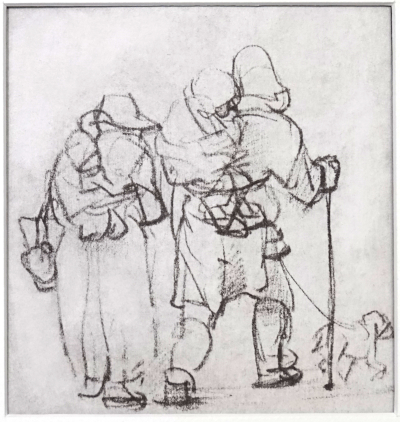
Couple of Beggars with a Dog
(circa 1647-48, Benesch, B 751, Schatborn
& Hinterding, D
390), {Albertina, Vienna}. The drawing Couple of Beggars with a Dog illustrates
how Rembrandt studies the construction of a quasi-static,
ephemeral scene—that is, one characterized by slow
movement. The lines are simple, outlining the forms of the
characters and the dog without dwelling on precise details
like hands or clothing. Yet,
the atmosphere of the scene is already perfectly conveyed:
one can sense the slow, trudging walk of the figures and the
contrast between the parents' effort and the peaceful sleep
of the children carried on their backs. This sketch is a
true freeze-frame of the “film” that Rembrandt is watching,
showcasing his extraordinary ability to memorize and analyze
a scene observed in just a few seconds. It is important to
remember that Rembrandt drew daily, both in his studio and
during his walks. He sketched life wherever he was—in the
street, the countryside, taverns, and all the places where
he could observe everyday reality.
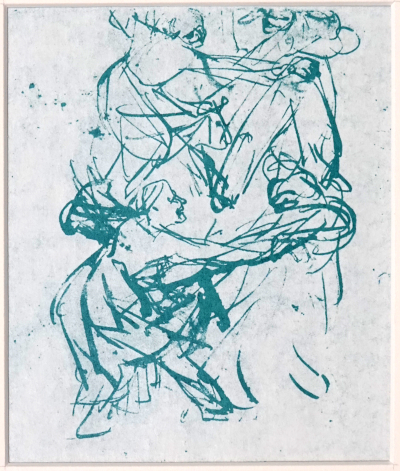
Country
People Dancing (circa 1635, Benesch, B
258 verso), {Graphische Sammlung,
Munich}. This drawing
depicts two country couples dancing at a
festivity. It demonstrates how Rembrandt
approaches the challenge of movement in a
fleeting and rapid scene. Unlike his treatment
of quasi-static scenes, here he seeks
primarily to understand and suggest movement
rather than precisely delineate the
characters’ forms. No detail is truly defined: with just a
few strokes, he evokes the swaying of the dancer
leading his partner, enhancing the sense of
movement by doubling the dancers' arms and the
woman's legs. This drawing gives the illusion of
superimposed successive images, like snapshots
from a rapidly moving film (see also the drawings
A Man Helping a Horseman
to Mount His Horse on
page 19 and Two Horses
at the Relay on page
23). The impression of dance and dynamism emerges
powerfully from this spontaneous sketch, created
with just a few lines. Rembrandt does not aim to
accurately represent the dancers but rather to
convey their momentum and liveliness. As a
finishing touch, he draws the women’s faces,
clearly expressing their amusement, while the
man’s head is merely sketched. This depiction of
the women's faces, reflecting their joy,
corresponds to the second stage of his method, in
which he focuses on conveying the characters’
emotions.
Combination of the two
variants of the first step
When Rembrandt observes a scene part of which
is quasi-static and part is rapid movement, he
combines the two variants into a single
drawing.
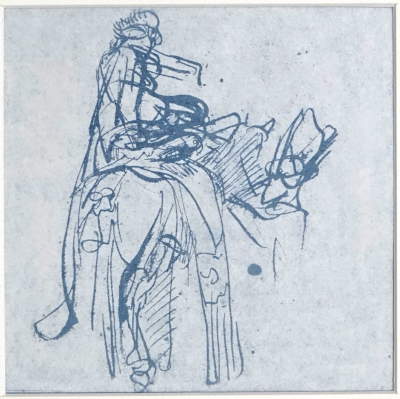
A
man helping a rider to mount his horse
(circa 1637, Benesch, B 363 recto, circa
1640-41, Schatborn &
Hinterding,
D 48), {Rijksmuseum, Amsterdam}.
Rembrandt observes a man helping a rider to
mount his horse. This drawing is a perfect example
of how Rembrandt combines a quasi-static part and
a rapidly moving part within the same composition.
The quasi-static part of the drawing is
represented by the horse and the man standing
beside it, drawn simply and precisely, like a
freeze-frame. Rembrandt sketches the horse's
hindquarters and a leg, hints at the head and
neck, and roughly draws the man assisting the
rider. The horseman is depicted with his left foot
in the stirrup and his left hand holding the
saddle, right at the moment he is mounting the
horse. The rapidly moving part corresponds to the
horseman in the act of climbing onto his horse. To
capture this dynamic motion, Rembrandt uses an
image overlay technique, doubling the right arm
and torso, and tripling the horseman’s right leg.
This approach perfectly conveys the momentum and
difficulty of mounting the horse, creating an
impression of movement with just a few swift and
energetic strokes. On the verso of this sheet,
Rembrandt drew A Rider with a Quiver, suggesting that he quickly moved from
dynamic study to a more composed image. The sketch A
Man Helping a Rider to Mount His Horse also inspired the depiction of the rider
in the painting The Concord of the State (1637–1645, Museum Boijmans, Rotterdam),
showing how Rembrandt reused and adapted his
graphic studies in other works.
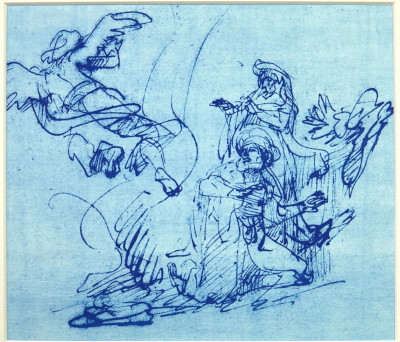
The Sacrifice of Manoach (circa 1637-40, Benesch, B 180,
circa 1635, Schatborn
& Hinterding,
D 54), {Kupferstichkabinett, Berlin}.
This drawing is one of Rembrandt's most
beautiful representations of an apparition and the
ascent of an angel. It illustrates the biblical
scene where Manoah and his wife, desperate from
being childless, sacrifice a lamb. Suddenly, an
angel appears in the flames to announce the birth
of Samson, the future liberator of Israel from the
Philistine yoke. This sketch belongs to the second
stage of Rembrandt's working method, where he
seeks to express the emotion and reaction of the
characters after having analyzed and understood
movement in a previous stage. Here, Rembrandt
captures the ascent of the angel, as well as the
backward movement of Manoah and his wife,
demonstrating their surprise, astonishment, and
fear. The focus is on the positioning of arms and
hands, as well as the angel's legs, to intensify
the sense of movement and lightness. Rembrandt
does not dwell on the precision of details such as
the characters' hands or the angel's feet, which
has unjustly earned him criticism for his supposed
inability to draw these body parts. However, this
deliberate omission clearly shows that his goal
here is to capture the essence and emotion of the
scene rather than detailing every element. The
freedom of the line and the unpredictable nature
of the stroke perfectly convey the ephemeral and
spiritual character of this apparition. Rembrandt
pays particular attention to the expression on
Manoah's face, while the expression of his wife is
less marked, indicating where his interest lies in
this study. This drawing embodies Rembrandt's way
of balancing spontaneity and technical mastery to
render the immediacy and emotional impact of a
scene. This sketch served as a source of
inspiration for other works by Rembrandt, notably
the painting The
Angel Leaving Tobit and his
Family (1637) and the etching The
Angel Leaving Tobit and
his Family
(1641). The treatment of the angel in these works
shows how Rembrandt progressively deepened and
enriched his understanding of movement and
expression, moving from preliminary study to
completed work.
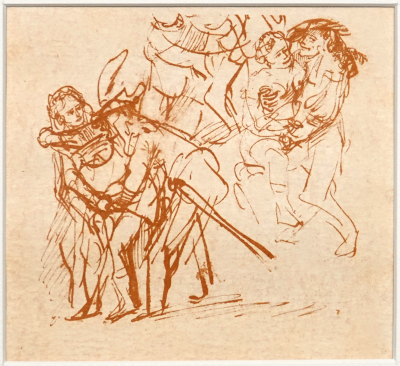
Three Soldiers Carousing with
Women (circa
1635, Benesch, B 100 verso, Schatborn
& Hinterding,
D 31), {Kupferstichkabinett, Berlin}. This drawing was
created during the same period as Rustic people dancing. It corresponds
to the second stage of Rembrandt's working
method. The artist has solved the problem of
constructing couples and is now primarily
interested in the expression of the
characters. The
soldier of the first couple tries to slip his hand
between the woman's thighs, to which she reacts
violently: she attempts to pull his hand away and
is about to slap him. Rembrandt doubles the
woman's right arm to suggest movement while
emphasizing the expression on her face. In the
case of the second couple, the artist depicts
characters having fun and exchanging caresses.
Combination of steps
1 & 2
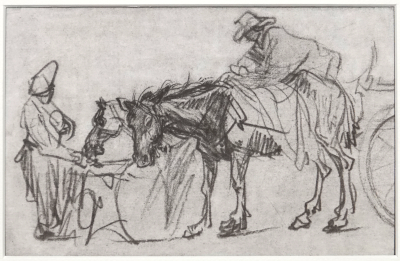
Two Horses in the Coaching Inn (circa
1637, Benesch, B 461, circa 1629, Schatborn & Hinterding,
S 460), {Rijksmuseum, Amsterdam}.
Two horses pulling a cart arrive to rest. The
driver places a blanket over the horses while a woman
offers one of them a piece of fruit. This study is
particularly remarkable because it combines the two
characteristic methods of the first and second stages of
Rembrandt’s study technique to depict a fleeting scene.
First, Rembrandt executes the quasi-static part, or
"freeze-frame," which allows him to structure his drawing.
This initial stage includes the cart, the driver, the
blanket, and the woman—represented in a very simple manner
without any detail. In the background, he then draws the
horse’s head as it eats the fruit offered by the woman,
corresponding to the study of movement from the first
stage. To suggest movement, Rembrandt doubles and even
triples the outline of the horse’s head, showing the
animal grabbing the fruit and beginning to chew it. This
technique of redoubling to indicate movement, known as repentir, is also observed in the
drawings Country
People Dancing and A
Man Helps a Rider to Mount his Horse. The technique of doubling to convey motion was
already employed in the Paleolithic and Neolithic periods
(for example, in ancient Egyptian art). Finally, Rembrandt
carefully details the expression of the horse’s head in
the foreground, as well as its neck and four legs,
corresponding to the second stage of his study method.
Once again, it is worth emphasizing Rembrandt’s
extraordinary memorization and analytical abilities,
enabling him to capture a fleeting scene with such
precision in just a few seconds.
Third
stage (volume)
The Naughty Boy
(circa 1635, Benesch, B 401, Schatborn
& Hinterding,
D 238), {Kupferstichkabinett, Berlin}.
This drawing corresponds to the third stage of
Rembrandt's artistic evolution. The artist has resolved
the challenges of construction, movement, and character
expression. He uses shadows and light to create a sense
of volume. To emphasize the violent and fleeting nature
of the scene, Rembrandt depicts the child's shoe coming
loose from his foot and about to fall. Although he pays
great attention to the movement of the two women and the
child, as well as to the facial expressions of the women
and the three children, he sketches the women's hands
and especially their feet only very briefly. In doing
so, Rembrandt focuses his efforts on the part of the
drawing intended to capture the viewer’s attention and
convey the dramatic character of the scene.
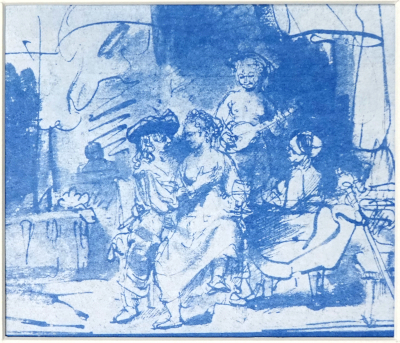
The Soldier at the Brothel or The
Soldier at the Tavern
(circa 1642-43, Benesch, B 529), {private
collection}. This
drawing is commonly known as The
Prodigal Son in the Company of Loose Women or The Prodigal
Son in the Tavern.
However, the man is wearing a dagger at his belt, and
his sword is placed along the armchair to the right of
the drawing, making the identification as the Prodigal
Son unlikely. This drawing represents the third stage
of Rembrandt’s method and appears as a miniature
painting. The freedom of the lines and the simplicity
of the setting are noticeable, as the artist’s main
interest lies in recreating the atmosphere and the
expression of the characters enjoying themselves.
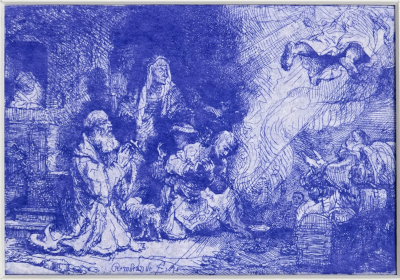
The
Angel Leaving Tobit and his Family (1641), {Rijksmuseum, Amsterdam}.
The archangel Raphael leaves Tobit and his
family after healing Tobit’s father’s blindness.
The family thanks the angel, who takes flight and
disappears. In this highly accomplished etching,
Rembrandt revisits the study of the angel from the
drawing The Sacrifice of Manoach. This etching corresponds to the third
stage of his artistic evolution and represents a
variation of the 1637 painting titled The Angel Leaving Tobit and His
Family. One of
Rembrandt’s unique traits is his ability to remain
interested in the same subject for several years
while offering very different representations. In
this etching, he focuses on Tobit’s family and the
characters’ expressions. It is worth noting that,
for Rembrandt, the small dog symbolizes the
family's loyalty to the archangel Raphael, whereas
in the Bible, the dog is considered a harmful and
ill-reputed animal. This demonstrates that when
depicting a biblical scene, Rembrandt imbues it
with his own personality, always prioritizing his
perspective over generally accepted conventions.
Rembrandt depicts only the lower part of the angel
in full flight, thus suggesting his rapid
disappearance from the sight of both Tobit’s
family and the viewer, witnesses to a fleeting
scene. Even the donkey appears stunned by the
angel’s ascent, enhancing the effect of surprise
and astonishment.
Young Woman Lying down, probably
Hendrickje Stoffels (circa 1655-56,
Benesch, B 1103, circa 1654, Schatborn
& Hinterding,
D 441), {British Museum, London}.
This drawing, made with brush and ink,
is one of Rembrandt's masterpieces. It reveals
what Rembrandt was capable of achieving once
he had resolved the preliminary difficulties.
One can almost trace the order of the
brushstrokes according to the amount of ink
left in the brush.
Keep the
Construction as Open as Possible
Rembrandt's passion for
freedom strongly influenced his way of
drawing. One of the characteristics of his
line is, indeed, the freedom of his stroke,
which is sometimes unpredictable. To preserve
this spontaneity, Rembrandt strives to keep
the structure of his drawing as open as
possible. The term "closing" the structure of
a drawing refers to when the initial strokes
constrain the development of the rest of the
drawing. For example, one might sketch a head
with an oval for a quick construction in the
preliminary phase, but one should not begin
with an oval if aiming to create a detailed
portrait. Similarly, when drawing a scene with
multiple figures, it is better to first
position the figures before adding the
background. To maintain the freedom of the
stroke, it is essential to delay the
introduction of constraints as much as
possible during the development of the
drawing. To
illustrate this principle, we will present a
preparatory study for the painting Saint John the Baptist Preaching. We will show how Rembrandt proceeds
when focusing his attention on a particular
character within a group.
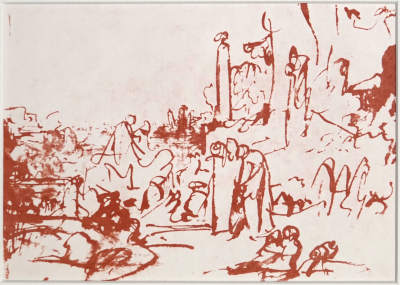
Preliminary Study (circa 1637 by Benesch,
B139A), {Private collection} for the
painting Saint John the Baptist
Preaching.
At this stage of the work, Rembrandt
draws the heads as ovals, as he is not yet
aiming to depict details or create portraits.
He first places the figures or groups of
figures, then positions the elements of the
background. This drawing represents the first
stage of Rembrandt’s study. At the bottom
right of the sheet, he suggests the presence
of a seated woman with a child on her lap, for
whom he will later create several studies. We
will present two
of these studies.
When Rembrandt focuses his attention on a
particular character within a group, it is
very interesting to observe how he draws
the group while avoiding closing the
structure of his drawing. We will present
the two drawings Guided
by an Angel, Lot and His Family Leave
Sodom and Lot and His Daughters,
in which Rembrandt concentrates on the
main characters, particularly on Lot. In
both works, he skillfully emphasizes the
main figures while allowing the
surrounding elements to remain more
loosely defined, creating a dynamic and
open composition. This
approach emphasizes the central characters
without restricting the fluidity of the
scene, adding a sense of movement and
spontaneity to the drawings.
Guided by an Angel, Lot and his
Family Leave Sodom
(circa 1636, Benesch B 129), {Albertina,
Vienna}. Guided by an angel, Lot, his wife, and
his daughters leave Sodom, destined for
destruction by God. The angel warns them not to
look back; however, Lot’s wife, defying this
warning to glance behind, will be turned into a
pillar of salt. Lot and his daughters will later
take refuge in a cave (see the following
drawing, Lot and His Daughters). To maintain the openness of his
composition, Rembrandt begins by drawing Lot with
great detail, using shadows to define the volumes.
He then depicts the angel and Lot’s wife, who
surround and guide him, and finally sketches the
two daughters following them in a more succinct
manner. This drawing is an excellent example of a
study sheet, revealing the three characteristic
stages of Rembrandt's work. Another interesting
point is the question of the drawing’s
attribution. On the verso of the sheet, there is a
drawing likely made about ten years earlier by a
student of Lastman. This led some experts to
speculate that the drawing might not be by
Rembrandt himself, but rather a copy made by
Govert Flinck (?) or Jan Victors (?) in the years
1640–45. Legend has it that when Rembrandt picked
up this sheet to draw, one of his students said, "No, Master, don’t use that sheet for
drawing, or in three hundred years, experts
might discredit your work!"
Rembrandt merely shrugged and drew on it anyway.
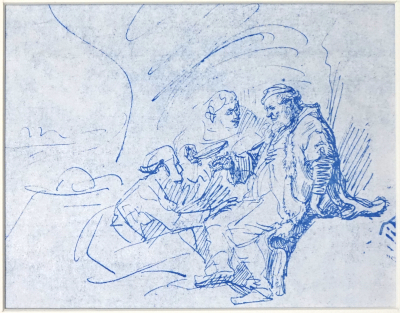
Lot
and his Daughters
(circa 1636, Benesch, B 128, circa
1638, Schatborn
& Hinterding,
D 57), {Klassik Stiftung, Weimar}.
After leaving Sodom, destroyed by
God, Lot and his daughters take refuge in
a cave where wine, placed there by divine
will, is found. The two daughters find
themselves alone with their father, as
their fiancés refused to follow them.
Fearing that they will have no descendants
in this isolated place, the eldest
daughter decides to intoxicate her father
to conceive a child and convinces her
younger sister to do the same. From this
incestuous relationship, two sons are
born: Moab, founder of the kingdom of the
Moabites, and Ben-Ammi, founder of the
kingdom of the Ammonites. The drawing
shows the eldest daughter (?) encouraging
her father to drink by handing him the
cup, while Lot, already intoxicated,
begins to sway. To maintain the openness
of his composition, Rembrandt starts by
drawing Lot in a very accomplished way,
except for his legs, which are sketched
more succinctly. Then, he draws the
expressive face and hand of the eldest
daughter urging her father to keep
drinking. Finally, he sketches the
silhouette of the younger daughter and
adds a few decorative elements. This
drawing is a magnificent example of a
study sheet, showcasing the three
characteristic stages of Rembrandt's work.
It was preceded by a more accomplished
drawing, Lot
and his Daughters (circa 1631), generally
attributed to the school of Rembrandt but
possibly by his own hand, and made popular
by Jan van Vliet’s etching
in 1631.
A
Line Sometimes Completely
Unpredictable
Finally, it should
be noted that Rembrandt’s drawing is
also distinguished by a line with a
completely unpredictable stroke,
displaying remarkable virtuosity (see
for example The
Sacrifice of Manoach).
Through this technique, Rembrandt
suggests what he wishes to represent
without precisely outlining the
contours. Rembrandt typically uses this
technique at the end of a drawing’s
execution to preserve the freshness and
vitality that emanate from it, avoiding
any stiffness or rigidity. A striking
example of this approach can be found in
the Portrait
of Saskia
from 1633.
Portrait
of Saskia
(detail of the drawing dated
1633 and annotated by Rembrandt,
Benesch B 427, Schatborn
& Hinterding,
D 629), {Kupferstichkabinett,
Berlin}.
Rembrandt created the portrait
of Saskia on June 8, 1633, three days
after their engagement. This drawing,
executed with a silverpoint on
parchment, begins with the depiction
of Saskia's face, hat, and left hand,
followed by her right hand. It is
interesting to note that the right
hand lacks the finesse of the other
and resembles more of a man’s hand. It
could, in fact, be Rembrandt’s own
hand, offering a flower to his beloved
fiancée. Next, he completes the two
sleeves and the shoulder of Saskia's
garment with lines that are entirely
unpredictable. This virtuoso stroke
suggests the shoulder and sleeves
without explicitly outlining their
contours, resulting in a far more
elegant effect than if the sleeves had
been drawn conventionally. This way of
drawing without closing the
construction is characteristic of the
happy period of Rembrandt’s life,
where spontaneity and freedom of line
reflect his state of mind.
To capture
the observer’s attention
For
Rembrandt, the important thing is
not merely to draw the whole
scene, but to focus on the part of
the drawing that interests him and
allows him to express what he
wants. This is the part that
should capture the observer’s
attention (see, for example: Three Soldiers Carousing
with Women,
Horses
at the Relay Station,
The
Naughty Boy, Accompanied
by an Angel, Lot Leaving Sodom
with His Family,
Portrait
of Saskia).
This way of approaching the
subject can also be found in
certain paintings executed after
1650. It
is worth noting that, in the
treatment of a subject in a
drawing or print, the theme
becomes secondary to the life he
breathes into his works (for
example: Omval).
To complete our discussion, we
will also present the painting A Woman Bathing in a
Stream and
Rembrandt’s studies of a
seated woman, as well as the
lithograph The
Mother and her Child
by Käthe Kollwitz and the print The Great Wave off
Kanagawa by Katsushika
Hokusai.
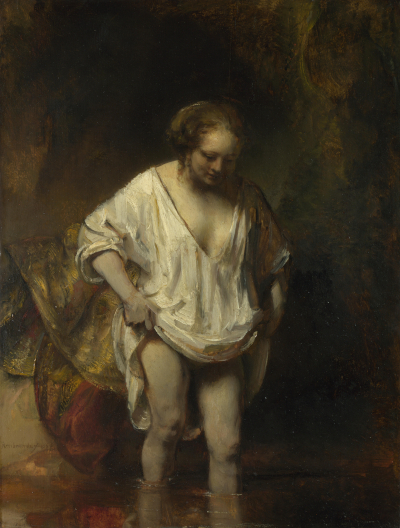
A
Woman Bathing in a Stream
(1654), {National Gallery,
London}. Rembrandt focuses on
the face of the woman entering
the water, thus expressing the
pleasure she feels at the
thought of bathing. He also pays
particular attention to the
small ripples created by the
woman’s legs in the stream,
suggesting the movement of her
entry into the water. The face
and the ripples on the water are
the only parts of the painting
treated with great delicacy and
meticulous finishing. In
contrast, the dress is painted
with remarkable virtuosity,
using broad brushstrokes and a
heavy application of paint. The
woman’s right hand, lifting the
dress, is sketched in a succinct
manner, yet this simplification
does not seem jarring unless one
focuses on the details. This way
of painting was completely
misunderstood by Rembrandt’s
contemporaries, who criticized
him for producing unfinished
works.
Studies
of a Seated Woman
(circa 1633, Benesch,
B179, circa 1639,
Schatborn
& Hinterding,
D 343), {Musée du Louvre,
Paris},
used in the painting
Saint John the
Baptist Preaching.
When Rembrandt
sketches the seated woman at
the bottom of the sheet, he
does not outline her face with
an oval, as he is focusing on
studying her expression. In
contrast, for the seated woman
at the top, he does use an
oval for the face, as he is
not interested in detailing
her features or exploring her
expression. Since Rembrandt
aims for a continuous, fluid
line—rather than composing his
drawings from separate,
disconnected strokes—he often
struggles with rendering hands
accurately. In the study of
the woman at the bottom, he
concentrates on her facial
expression and left hand.
While the hand is not drawn
with great precision, it
effectively conveys that the
woman is a poor beggar,
reaching out for money or
food. In the upper study,
Rembrandt focuses more
precisely on the
representation of two
children, drawing them with
greater clarity than in the
lower study. These two seated
woman studies were later
followed by a third, distinct
study. Notably, all three
differ from the final painted
version.
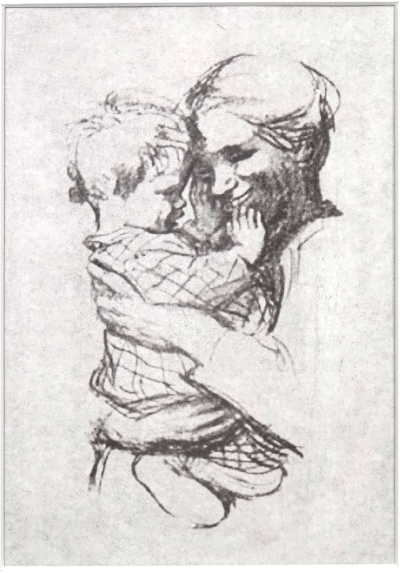
The
Mother and her Child (1916,
Lithography) by Käthe
Kollwitz
is a poignant and
emotive work, characteristic
of the artist's
expressionist style. Known
for her social and
humanistic works, Kollwitz
often explores themes such
as suffering, love, and
class struggle. In this
lithograph, she meticulously
depicts the faces of the
mother and child, as well as
the child’s two hands. She
highlights the intensity of
maternal love through the
profound and sensitive
expressions on their faces.
The gazes of both
figures—the mother and the
child—are the focal point of
the piece. It is through
these gazes that the artist
conveys the emotions and the
intimate bond that unites
them. The mother gazes at
her child with immeasurable
love and palpable
tenderness, while the child
appears both dependent and
confident, feeling secure in
the maternal embrace. The
lack of precise detail in
the depiction of the
mother’s hands reinforces
the idea that technique is
not the core of the work,
but rather the pure
expression of feelings. This
deliberate inaccuracy can be
seen as a simplification
intended to allow the viewer
to focus on raw emotion
without distraction. The
representation of the mother
and child, devoid of
ornamentation or
embellishment, gives the
work a sincerity and
universality that transcends
technique, directly touching
the viewer’s soul.
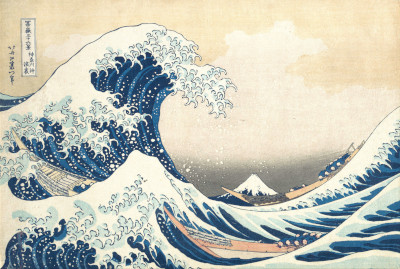
The Great Wave off
Kanagawa, a woodblock
print by Katsushika
Hokusai (1831), is part
of the famous series Thirty-Six
Views of Mount Fuji (Fugaku
Sanjūrokkei). Similar to
how Rembrandt's etching
Omval renders the
subject secondary, Mount
Fuji becomes less
prominent here; what
truly interests Hokusai
is, above all, the
fishermen's way of life.
He depicts a massive
crashing wave off the
coast of Kanagawa Bay,
with Mount Fuji
appearing in the
background. It is
noteworthy that,
although Mount Fuji is a
sacred symbol of Japan,
Hokusai focuses on the
fishermen, whose fragile
boats struggle against
the vastness of the sea
and the power of the
wave. This approach
reflects a form of
humanism, where the
harsh living conditions
of the
fishermen—belonging to
modest social
classes—are elevated to
the same level as Mount
Fuji, sacred yet
distant. By portraying
the fishermen's battle
against the forces of
nature, Hokusai elevates
these common figures to
an almost mythological
status, granting them
remarkable dignity
through the power of his
depiction. Through its
dynamic movement and
depth, Hokusai’s
composition is a
masterpiece of Japanese
art from the Edo period.
The great wave, with its
vibrant energy and
abstract form, has
become one of the most
recognizable images of
Japanese art and
woodblock printing.
To illustrate
everything we have
just discussed, we
present Study for
the Lamentation of
Jacob.
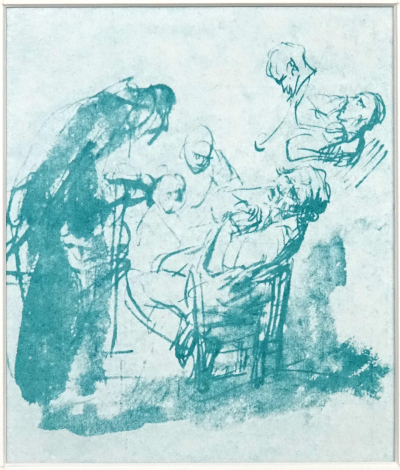
Study for the
Lamentation of
Jacob (circa
1635, Benesch, B
95, Schatborn
&
Hinterding,
D 40),
{Kupferstichkabinett,
Berlin}.
This drawing
perfectly embodies
Rembrandt’s artistic
approach and
illustrates the
principles
previously
discussed. Jacob,
the grandson of
Abraham, is depicted
in a posture of
intense lamentation,
pleading with a
specter that appears
in his distress.
Convinced that it is
a vision of God,
Jacob is, in
reality, confronted
by the specter of
his twin brother,
Esau. A vision of
God would have
caused his death.
Jacob is known as
the father of
Joseph, who was
falsely accused by
Potiphar's wife of
attempting to seduce
her. In this
study, we find
Rembrandt’s
exceptional mastery of
line: a freedom of
execution that
preserves the
freshness of the
drawing while
maintaining remarkable
emotional power. The
contours remain open,
allowing shapes to be
suggested rather than
fixed, reinforcing the
impression of movement
and spontaneity. The
line work is both
dynamic and subtle,
enabling emotions to
emerge almost
instinctively. This
virtuosity contributes
to the humanity that
emanates from the
work, bearing witness
to Rembrandt’s
profound artistic
depth.
Evolution
of Rembrandt's
line
As previously
mentioned, the use of
a line with a
completely
unpredictable stroke
is characteristic of
the happy period of
Rembrandt’s life. His
style evolved
considerably toward
the end of his life,
particularly after
1655. After his move
in 1660, when his
press had been seized,
Rembrandt produced
very few etchings. It
is also possible that
his output of drawings
decreased, especially
since very few
drawings from this
period have survived.
This stylistic
evolution became more
pronounced after the
death of Hendrickje
Stoffels in 1663. To
illustrate this
evolution in
Rembrandt’s line, we
will present the
drawing Diana
and Actaeon.
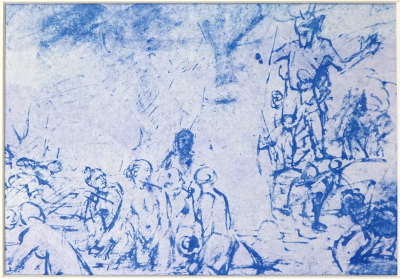
Diane
and Acteon, (circa
1662-65, Benesch -
B 1210, circa
1656, Schatborn
&
Hinterding,
D 161),
{Kupferstichkabinett,
Dresden},
is probably one
of the last known
drawings by Rembrandt.
In his later years, he
revisited this theme,
creating a free
adaptation of an
engraving by Antonio
Tempesta (1555-1630).
Although the drawing
retains a great deal of
freedom in execution, it
has been greatly
simplified: curves are
often replaced by
straight lines, and the
stroke becomes stiffer,
more angular, and
rudimentary. Rembrandt
more frequently used
reed or bamboo, which
allowed him to achieve a
line that was both
vigorous and highly
nuanced. One can notice
the extraordinary
efficiency with which he
represents the heads and
faces of Diana and her
attendants. After the
death of Hendrickje
Stoffels and all the
hardships he had
endured, Rembrandt, now
beyond the pain, sought
to avoid any unnecessary
embellishment,
prioritizing simplicity
and the essential. The
unpredictable strokes,
so characteristic of his
earlier periods,
disappear from his late
drawings. This stylistic
evolution may have been
amplified by health or
vision problems, and it
is also evident in his
paintings. However, this
style confused his
admirers, who considered
his works unfinished and
were no longer eager to
purchase them. Yet,
Rembrandt, detached from
the opinions of
potential buyers,
continued his personal
artistic quest.
Rembrandt's
perception and
representation
of volume
As we mentioned
earlier, Rembrandt
never drew the
scenes he studied in
the same way twice.
The final version of
the scene he wished
to represent was
always different
from the preparatory
studies he had made.
This working method
allowed him to
approach the subject
or scene in three
dimensions, thereby
strengthening his
spatial
understanding of the
motif. Arnold
Houbraken
(1660–1719) reports
in this regard: “It often
happened that he would
sketch a face in ten
different ways before
reproducing it on the
canvas.” As a draftsman,
etcher, and painter,
Rembrandt always sought
to convey the volume of
the scene depicted, in a
way that gave the viewer
the impression of
observing not a static
image projected in two
dimensions, but a
living, natural scene,
and therefore more
human. Early on, he
understood that one of
the ways to resolve this
issue was through the
use of chiaroscuro and,
more broadly, the play
of shadows and light.
This is already clearly
visible in the painting
The
Parable of the Rich
Fool
(Gemäldegalerie,
Berlin), created in
1627, three years after
he set up his studio in
Leiden. To accentuate
the sense of volume in
his paintings, Rembrandt
frequently depicted
backgrounds in a blurred
manner, thus enhancing
the illusion of depth.
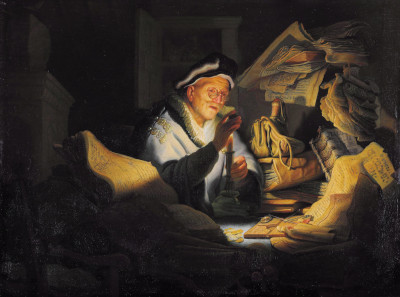
The portrait of
Jan Cornelis
Sylvius is the
most
extraordinary
example of
Rembrandt's
exploration in
etching, aiming
to give the
viewer an
impression of
volume, life,
and naturalness.
Portrait
of Jan Cornelis
Sylvius,
Rembrandt (1646),
{Rijksmuseum,
Amsterdam}.
To
enhance the
impression of
volume,
Rembrandt
imposes a
precise viewing
angle on the
spectator by
drawing the
perspective of
the mat's bevel.
This positioning
places the
viewer slightly
below and to the
right of Jan
Cornelis. The
light,
meanwhile, also
comes from the
right but from a
source
positioned
higher than the
model. To
reinforce
the effect of
relief, Rembrandt
makes the right
hand, the book, and
Jan Cornelis’s head
literally emerge
from the plane of
the image by casting
their shadows onto
the mat. This
technique gives the
portrait a striking
sense of life and
humanity. Rembrandt
transcends mere
anecdote to create a
work that goes
beyond a simple
projection on paper.
The
catalogues
of Rembrandt's
drawings
(An
example of a
problem of
attribution)
The two most
comprehensive
catalogs of
Rembrandt's
drawings are Otto
Benesch's catalog,
The Drawings
of Rembrandt,
(1973), in six
volumes, and the
catalog by Peter
Schatborn and Erik
Hinterding, Rembrandt:
All the Drawings
and Etchings,
(2019). There are
also many other,
more partial
catalogs, which we
will not list
here.
As previously
mentioned, most of
the drawings by
Rembrandt or his
circle of students
were generally
neither
dated nor signed,
making their
dating and
attribution
extremely
difficult to
establish with
certainty.
The Benesch
catalog (1973)
provides a
description, a
history, and the
reasons for
attributing each
drawing to
Rembrandt. The
Schatborn and
Hinterding
catalog (2019)
is a revision
and update of
the Benesch
catalog (1976),
using the
criteria
explained in
Schatborn &
van Sloten
(2014). The
latter is
intended for a
broad audience
and does not
include
descriptions,
histories, or
explanations of
the reasons for
attributing each
drawing to
Rembrandt.
The
main
issue with the
Schatborn (1985)
and Schatborn
& Hinterding
(2019) catalogs,
based on the
criteria from
Schatborn &
van Sloten
(2014), is that
they do not take
into account two
fundamental
characteristics
of Rembrandt’s
drawing
technique. The first
characteristic
concerns the way
Rembrandt approaches
a subject: when he
discovers a subject,
he begins by
studying its
proportions and
movement. If the
subject moves
slowly, he creates a
“freeze-frame” (for
example, Beggar
Couple with a
Dog). However,
if the subject moves
quickly, he opts for
an overlay of images
that depict motion
(for example, Dancing
Peasant Couple, A Man
Helping a Rider
Mount His Horse, Three
Soldiers
Carousing with
Women, Two
Horses at the
Relay or the
Farm, The
Horse
Eating a Fruit
from the Woman’s
Hand). The
second overlooked
characteristic is
that Rembrandt never
drew the same
subject in the same
way twice. In other
words, he never
copied a drawing or
an etching, allowing
him to maintain
great spontaneity
and freshness of
line in his
drawings, etchings,
and paintings.
It is very
interesting to
observe how
these two
shortcomings can
influence
conclusions and
deductions,
taking as an
example the
drawing A
Man Helping a
Rider Mount
His Horse.
This drawing
combines both
methods from the
first step: it
features a
"freeze-frame"
for the almost
static part,
with the horse
and the man
assisting the
rider, and an
overlay of
images depicting
the rider’s
movement as he
swings his leg
over the saddle
to mount the
horse (see page
19). On the
reverse side,
Rembrandt drew a
rider with a quiver,
suggesting that
immediately after
completing this
study, he turned the
sheet and drew a
rider wearing a
feathered hat on his
horse. This sketch
would later be used
by Rembrandt in the
etching The
Baptism of the
Eunuch (1641).
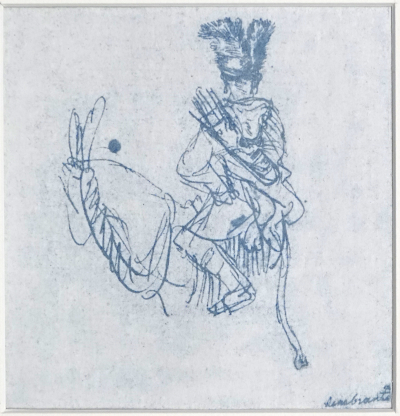
Rider with a
Quiver, (circa
1662-65, Benesch – B
1210), {Rijksmuseum,
Amsterdam}. This
sketch will be used
latter by Rembrandt
for the etching The
Baptism of the
Eunuch
(1641).
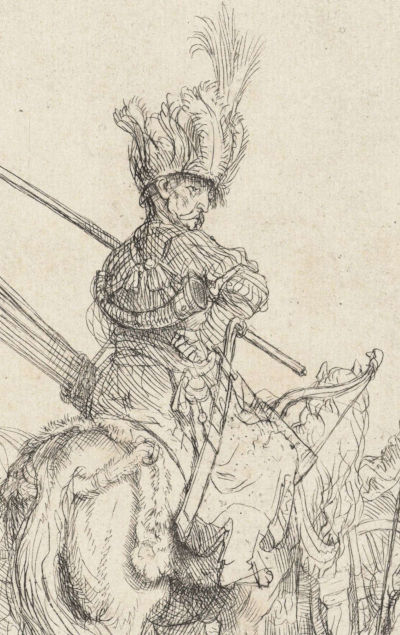
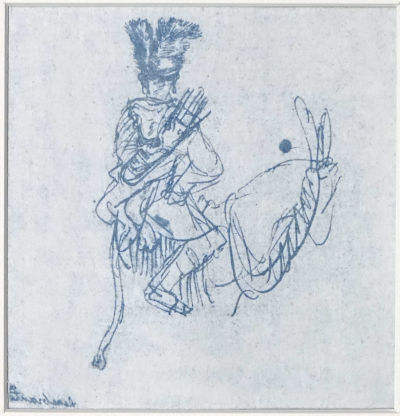
To
preserve the
freshness and
spontaneity of the
line, Rembrandt
etched a variant of
the sketch A
Rider with a
Quiver without
reversing the
drawing. This is a
typical working
method of Rembrandt.
Regarding the
drawing A Man
Helping a Rider
Mount His Horse,
Schatborn (1985,
page 46) does not
write, « Rembrandt
created a
beautiful study of
the movement of a
rider mounting a
horse », but
instead concludes
that « Rembrandt
tried to draw a
rider mounting a
horse, but he does
not seem to have
found a
solution... ».
It is interesting to
analyze the
consequences of this
initial
misunderstanding.
Indeed, Schatborn
deduces that « This
shows that
Rembrandt did not
draw from a model
but worked from
memory... » To
explain the drawing
of the rider on the
reverse side of the
sheet, he asserts: «
The drawing on
the reverse is not
by Rembrandt but
was added by a
dealer to make the
sketch of the
rider mounting his
horse more
attractive for
sale! »
Therefore, Schatborn
(1985) does not
attribute the
drawing A Rider
with a Quiver
to Rembrandt, and
this sketch is not
included in the
catalog of
Rembrandt's drawings
by Schatborn and
Hinterding (2019).
Legend has it that
after finishing
these sketches,
Rembrandt went to a
tavern with one of
his students. The
student, after
examining the
sketches, said to
Rembrandt: « Master,
you should explain
your sketches and
your working
method, for one
day an expert
might write »:
« Rembrandt
tried to draw a
rider mounting a
horse, but he does
not seem to have
found a
solution... »
Rembrandt’s response
has not reached us,
but it is easy to
imagine. Indeed,
Rembrandt and his
circle of students
had little regard
for art critics,
who, without
practicing drawing,
etching, or painting
themselves, believed
they were connected
to a higher truth
(see the drawing Satire
of the Art Critic).
These examples help
to understand the
difficulty of
attributing drawings
to Rembrandt or his
students, as well as
the potential
fragility of
experts'
conclusions. They
also demonstrate
that having drawing
skills is not
without value when
it comes to fully
grasping Rembrandt's
drawings and method,
especially in
distinguishing a
movement study from
a finished drawing.
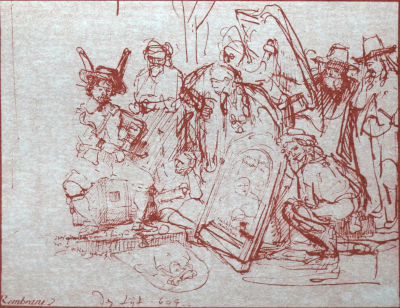
Satire of the Art
Critic (c.
1644, Benesch –
A35a, c. 1638,
Schatborn &
Hinterding, D 318),
{Metropolitan Museum
of Art, New York}.
This work is a
caricature of an art
critic, drawn by
Rembrandt or one of
his pupils. An
ironic twist in the
history of
attributions:
Benesch (1973)
attributes this
drawing to a pupil
of Rembrandt, while
Schatborn &
Hinterding (2019)
attribute it
directly to
Rembrandt.
References
for this section :
- Benesch O.,
1973, The
Drawings of
Rembrandt (six
volumes),
Phaidon
- Schatborn P.,
1985, Catalogue
of the Dutch and
Flemish Drawings
in the
Rijksprentenkabinet,
Volume 4,
Rijksmuseum,
Amsterdam, page
46
- Schatborn P.
& van Sloten
L., 2014, Old
drawings, new
names,
Uitgeverij de
Weideblik, Varik
and the
Rembrandt House
Museum
- Schatborn P.
& Hinterding
E., 2019,
Rembrandt, tous
les dessins et
toutes les eaux
fortes, Taschen
|
|


